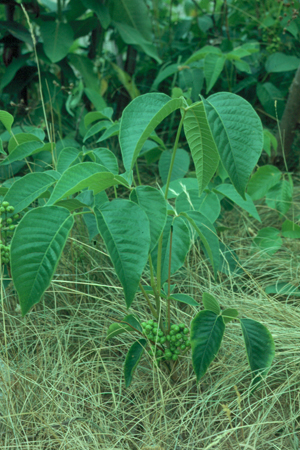Wildlife and plant safety
Fathom Five National Marine Park
Don’t feed wildlife
Viewing wildlife is an exciting visitor experience, but it’s important to remember that these animals are wild. Wildlife encounters can be dangerous for both the visitor and the animal. By following a few simple guidelines, you’ll be helping to protect yourself and the animals in our park.
It is unsafe and illegal to feed, entice or disturb any animal in a national park. Feeding puts both you and the animal at risk. In addition:
- Do not litter or discard food scraps. Animals that have been fed, directly or indirectly are more likely to approach and potentially harm people.
- Properly store food, garbage, and food related items in your vehicle. Keep food smells to a minimum.
Harmful Plants
Giant Hogweed and Wild Parsnip
Giant Hogweed and Wild Parsnip are invasive species that are increasingly common in southern Ontario and disturbing them can result in significant health effects. Toxins in the plant’s sap are photosensitive and can cause skin to react severely when exposed to sunlight and sap in the eyes can cause temporary blindness. If you see this plant or suspect you have seen it do not touch it and report the details to park staff.
How to identify Giant Hogweed:
Giant hogweed is not common in Bruce Peninsula National Park but may be found growing along roadsides, ditches and streams or in old fields and open woodlands.
- Can reach a height of 2.5-5 metres
- Large white, umbrella shaped flower clusters 30-90 cm across
- Prominent purple blotches and coarse bristly hairs on the stem
How to identify Wild Parsnip:
Wild Parsnip is commonly seen along the roadside of Highway #6 and in open fields.

Poison Ivy
Poison Ivy is commonly found in the park, it is found in patches growing low to the ground or as a climbing vine. Sap from any part of the plant can cause a severe, itchy and blistering rash. The severity of the rash depend the persons sensitivity and the amount of sap they are exposed. If poison ivy is burned and the smoke is inhaled or if the plant is accidentally eaten, the rash can occur internally causing extreme pain, breathing problems and organ damage. Pets will not get a rash but can transfer the sap to humans from their fur.
How to Identify Posion Ivy:
Poison ivy is commonly found along trails, woods and roadsides in the park.
- Three pointed leaflets – the middle leaflet has a longer stalk than the other two.
- Edges can be smooth or toothed.
- Leaves vary in size from 8-55 mm in length.
- Leaves are reddish in the spring, green in the summer and various shades of yellow, orange and red in the fall.
If you suspect you have come into contact with poison ivy wash the area with cold water and soap, this may decrease your chances of getting a rash and prevent it from spreading. Seek medical attention as necessary.
Vector-Borne Diseases
West Nile Virus
Spread by bites from infected mosquitoes, West Nile Virus causes fever, headache, body aches and a mild rash. Few cases are reported in Ontario every year, but if you spend time outdoors around mosquitoes you are at risk. The following tips can help protect you from mosquito bites and decrease your risk of contracting West Nile Virus.
- Mosquitoes are most active at dawn and dusk - wear long sleeves, pants and socks if you are outside.
- Wear light coloured clothing – mosquitoes are attracted to dark colours.
- Use insect repellent. Those containing DEET are most effective.
- Close screens to prevent mosquitoes from entering homes and tents.
Lyme Disease
Lyme disease is spread to humans by blacklegged ticks infected with the bacteria Borrelia burgdorferi. The symptoms of Lyme disease vary from person to person and if left untreated can persist for months to years. Symptoms may not appear for weeks after a bite from an infected tick. The best way to protect yourself from Lyme disease is to prevent tick bites. Although there are no reported cases from the park, precaution is still wise. The following tips will help protect you from tick bites and decrease your risk of contracting Lyme disease.
- Stay on the trail – avoid contact with vegetation. Ticks wait on vegetation for an animal or human to walk within reach of their legs and crawl onto the host.
- Wear insect repellent. Those containing DEET are most effective.
- Do a full body tick check on yourself, children and pets.
- Bathe or swim after outdoor activity to wash away loose ticks.
If you are bitten by a tick, removing the tick within 24-36 hours decreases your chance of infection. Remove the tick carefully and then wash the bite with soap and water or disinfect with alcohol. Save the tick in a zip-lock bag and record the date of the bite, this will help your health care provider assess your illness if you develop symptoms in the following weeks.
Rabies
Rabies is a virus that infects mammals. You can become infected with rabies if an infected animal bites you or saliva from the infected animal enters your body through your eyes, nose, mouth or an open wound. Avoid contact with all wildlife.
- Date modified :